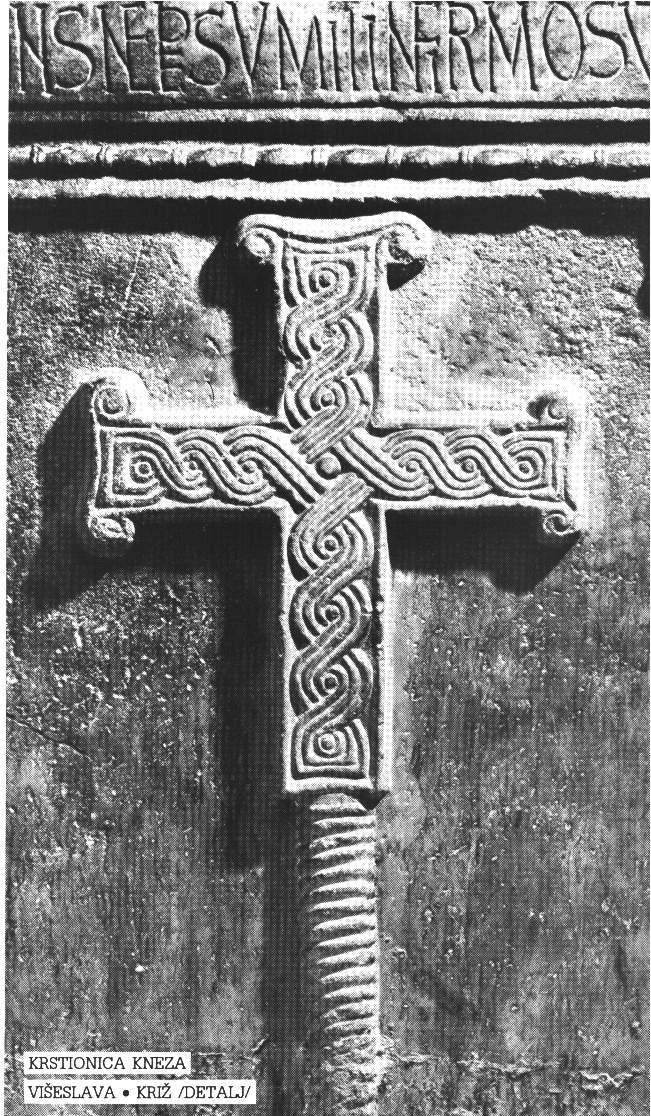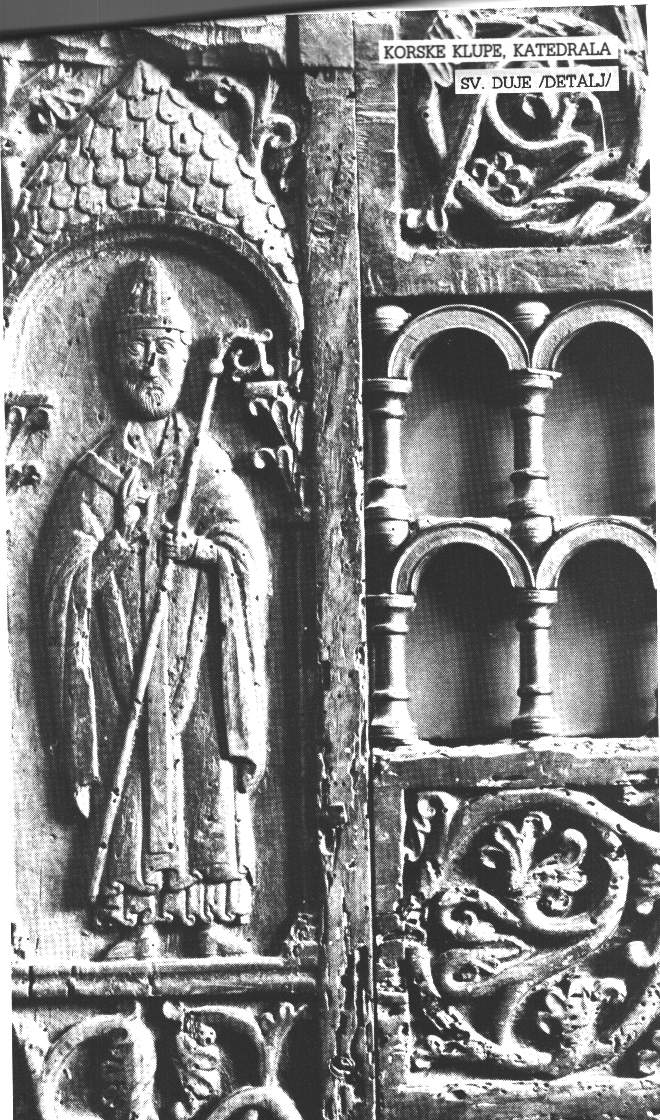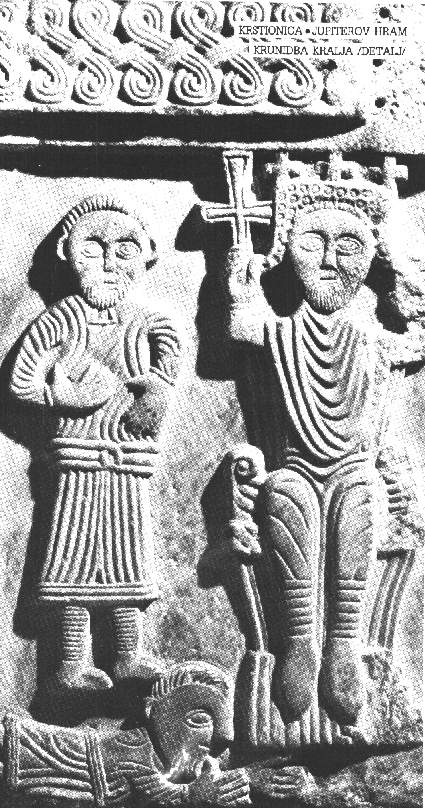



| Krstionica kneza Višeslava |
| Korske klupe u katedrali sv. Duje |
| Biskup Grgur Ninski |
| Krunidba kralja Zvonimira |
|
Split je gospodarsko i prometno
srediste Dalmacije, s brojnim kulturnim i znanstvenim ustanovama,
medu kojima ]e i Sveuciliste. Sa svojih 189 388 stanovnika (popis
1991.) najveci je grad na hrvatskom dijelu istocne jadranske
obale. Dioklecijanova palaca s povijesnom
jezgrom registrirana je u UNESCO-vom registru spomeriika kulture
svjetske kultumebastine. Na mjestu danasnjeg Splita, naseljenom
od davnina, car Dioklecijan dao ]e oko 295.-305. g. sagiaditi palacu u koju se povukao. S vremenom se palaca pretvorila u
grad, osobito tijekom vn. st. kad se u nju sklonilo pucanstvo iz
razorenog grada Salone (danas Solin). Split je u srednjem
vijeku stekao status autonomne komune; nadbiskup, pak, obnasa cast primasa Dalmacije i Hrvatske. Od Dioklecijanove palace sacuvane su zidine, vrata i
kule. Podmmske prostorije raznolikih oblika
ponavljaju raspored carskih odaja koje su se nalazile nad njima.
Peristil, sredisnji prostor Dioklecijanove
palace, postao je katedralni trg. Carev mauzolej pretvoren je u katedralu u kojoj se stuju grobovi svetog Dujma i Anastazija, mucenih u
vrijeme Dioklecijana. Fred ulazom
u mauzolej - katedralu bdije i danas egipatska sfinga. Nad pristupnirn stepenistem dize se zvonik graden u romanickom stilu od
XIII. do XV. stoljeca, no
temeljito restauriran u XX. stoljecu. Na vratima su drvene vratnice
koje je u XIE. stoljecu ukrasio
majstor Buvina reljeQrna sto prikazuju scene iz zivota Kristova. U
unutrasnjosti se posebno
isticu grobrrice-kapele: nad ranokrscanskim sarkofagom-grobnicom sv.
Dujma dize se kameni Jiator s kipovima sto ih je god. 1427. izradio
Bonino iz Milana; grobnicu sv.
Anastazija s reljefima iJdpovima isklesao ]e god. 1448. Juraj
Dalmatinac. Propov-jedaonica
s ukrasenim kapitelirna datira iz XIII. stoljeca, kad su izradene i
drvene korske klupe. U
sakristiji su dragocjene umjetnine; medu njima je i Splitsko
evandelje iz VII. stoljeca
koje su vjerojatno donijeli bjegunci iz razorene Salone. Hram
zapadno od Penstila preinacen je u krstionicu u kojoj je krsni zdenac sastavljen od
ukrasenih ploca, od kojih jedna
vjerojatno predstavlja hrvatskog kralja. Hodnici na zidinarna palace
pretvoreni su u ranosrednjovjekovne
crkvice; tako se kapelica sv. Martina ugnijezdila ponad sjevernih, tzv.
Zlatrrih vrata, dok se ona sv. Teodora (Gospa od zvonika) uvukla u
hodnik uz zapadna, . tzv. Zeljezna vrata. Mnoge spomenicke zgrade adaptirane su
u muzeje i kulturne ustanove. Muzej grada Splita smjesten je u Papalicevoj gotickoj palaci iz XV. stoljeca, na kojoj su
medutim vidljivi i stariji anticto,
predromanicki i romanicki zidovi, sto je svojstveno i dnrgim
splitskim zdanjima. Etnografski muzej nalazi se u nekadasnjoj
gotickoj knezevoj palaci, na glavnom trgu
u novom dijelu grada koji se prosirio izvan palace. Arheoloski
muzej, najstariji u Hrvatskoj, cuva velik broj
vrijednih starina, posebno onih antickih, uglavnom iz Salone.
Galerija umjetnina omogucava uvid u povijest likovnih umjetnosti u
Dalmaciji, osobito novijeg doba. Muzej hrvatskih arheoloskih spornenika
smjesten na juznim padinama opjevanog brzuljka
zvanog Marjana cuva dragocjenu spomeriicku gradu najstarije hrvatske
povijesti. U blizini je i Galerija Mestrovic u kojoj su izlozena
djela velikog hrvatskog kipara Ivana Mestrovica
(1883.-1962.). Split, smjesten na raskrizju putova sto vode duz
obale i prema unutrasnjosti, veoma je ziv, prometni grad s
trgovackom i putnickom lukom, sa zeljeznickom prugom i medunarodnom zracnom lukom. Trajektnim vezama Split je povezan s
otocima, sa sjevernim i juznim Jadranom, te s
Italijom i Grckom. Trgovacka i putnicka flota splitskih brodara
pospjesuje medunarodnu trgovrnu. Split je poznat po brodogradnji
i metalnoj industriji, no ne zaostaje ni kemijska industrija, a u
novije vrijeme proizvodnja solamih celija. Graditeljska poduzeca grade diljern svijeta. U okolini Splita su plodna
polja sto je osnova bogate poljoprivrede. Prirodne
Ijepote i vrijedna kulturna bastina omogucile su razvitak turizma.
Znanstvene ustanove zapazene uspjehe postizu u zastiti i
proucavanju kulturae i prirodne bastine, posebno
u oceanografiji. Izucavaju se jadranske poljoprivredne kulture.
Graditeljstvo prati i znanstveno-projektantska djelatnost. Split je festivalsko srediste. U povijesnim
ambijentima grada odrzavaju se dramske i glazbene
predstave Splitskih Ijetnih igara.
|
Split
is the economic and traffic center of Dalmatia. as well as a University
seat with numerous cultural and scientific institutions. With its 189 388
inhabitants (1991), Split is the largest city of the Croatian pan of the
East Adriatic Coast. The Diocletian's Palace with the historic center, has
been established by the U.N.E.S.C.C.O. as part of the World cultural
patrimony. The site of present-day Split was settled from times
immemorial. Between 295 and 305 the emperor Diocletian built a magnificent
palace here, in which he ended his days. With the passage of time, the
palace became the core of a new city. Its growth was particularly rapid in
the 7C, when the inhabitants of the destroyed Roman metropolis Salonae
(present-day Solin), took refuged inside its walls. In the Middle Ages
Split had the status of autonomous commune while its archbishop held the
position of the prrrnas of Dalmatia' and Croatia. Only the walls, gates
and tower of the ancient palace survived. Its cellars of various forms
repeat the arrangement of imperial premisses built above. The central area
inside the palace, the Peristyle, became the Cathedral square, while the
Emperor's Mausoleum was converted into the Cathedral devoted to St.
Domnius' (Sv. Duje) and St. Anastasius, two saints martyred at
Diocletian's time, whose tombs it still contains. Outside the Cathedal the
visitor may admire an authentic Egyptian Sphinx. Towering high above the
stone staircase that accesses the Cathedral, is a belfry built in the
Romanesque style of the 13/14C. The 12C carved Cathedral doors, with
scenes from Christ's life, were decorated by Master Bmrina. Inside, of
outstanding interest are two chapels with tombs: the early Christian tomb
in the form of sarcophagus, belonging to St. Domnius and vaulted by stone
canopylike structure with the statues made in 1427 by Bonino from Milan:
the tomb of St. Anastasius, ornamented with reliefs and statues, carved in
1448 by Juraj Dalmatinac. The pulpit with its decorated capitals goes down
to the 13C. From the same century are also the wooden choir stalls. The
Sacristy contains many valuable works of art. The most outstanding
attraction of the collection is a Gospel from the 7C. It is supposed that
it was brought here by the fugitives from the destroyed Salonae. The Roman
Temple located west of the Peristyle was later converted into the
Baptistery whose baptismal font is made of large decrated slabs. It is
considered that one of them features a Croatian king. In early Christian
period parts of the corridors topping the city walls were converted into
churches. One of them is St. Martin, nesting above the northern city gate
(the so called Golden Gate) and the other is St. Theodore (Our Lady of the
Companile), recessed into a passage in the vicinity of the western gate
(Iron Gate).
Many
of the town's historical buildings now accommodate museums and galleries.
The 15C Papalic Palace, whose masonry, like that of many other palacces in
the town, reveals Roman, pre-Romanesque and Romanesque layers, houses the
City Museum. The Etnographic Museum is in the former Prince's Palace in
the main square, in the new part of the city which spread beyond the
palace walls. The Archeological Museum, the oldest of that kind in
Croatia, contains many valuable ancient relics and monuments, mainly
antiquities from Salonae. The paintings and sculptures exhibited at the An
Gallery of Split illustrate the history of modern art in Dalmatia. The
Museum of Croatian Archeological Monuments is placed on the southern
slopes of Mount Marjan, celebrated in song. Standing nearby is Mestrovic
Gallery with the works of the great Croatian sculptor Ivan Mestrovic
(1883-1962).
Owing
to its very geographical position, astride the important traffic routes
leading inland and along the coast, Split is a busy port, with train
connections, an international airport and regular ferry services with the
nearby islands, the north and south Adriatic, Italy and Greece. The
merchant and passenger ships of the Split shipowner may be encountered in
almost all the seas of the world. Renown for its shipbuilding industry and
metallurgy, the city also has large chemical works and, recently,
workshops for the production of solar cells. The local construction firms
work on building-sites all around the world. The fertile fields in the
city surroundings represent a good base for agriculture, while cultural
monuments, superb landscapes and seascapes make it an ideal tourist
center. The scientific institutions seated in the town have achieved
remarkable results in the research and protection of cultural patrimony
and natural environment, particularly oceanography. Studied are also
Mediterranean field crops. The construction industry is closely connected
with scientific-design activity. Split is a festival center. Staged every
summer in the historical settings of the city are music and drama
performances of the Split Summer Festival.
The
most popular sports are football, water-polo, basketball, tennis and all
water-sports. Split was the host of three great international sports
events: The Mediterranean Sport Games (MIS 79) in 1979. the European
Swimming Championships (PEP 81) and the European Athletics Cahmpionships
(PEA 90).
Split
is the seat of the Split-Dalmatian county, which includes 10 towns (Hvar,
Kastela, rmotski, Makarska. Omis, Sinj, Solin, Split. Trogir, Vis) and 36
districts.
|
|
||||||||
|
||||||||
|
La ville de Split est le centre economique et
le carrefour des communications de la Dalraatie, avec nombreuses
institutions cultureBes et scientifiques, parmi lesquelles ii faut
citer I'Universite. Avec une population de 189388 habitants
(recensement de 1991) c'est la plus grande ville sur la partie
create de l'Adriatique
orientale. Le Palais de Dicletien avec le noyau historique est
inscrit dans le registre des monuments culturels de valeur universelle de 1'UNESGO. A 1'emplacement de 1'actuelle ville de Split,
habite depuis les temps les plus recules, 1'empereur Diocletien fit
construire entre 195 et 305 un palais pour s'y retirer. Au cours du
temps, le Palais se transforme en ville, particulierement durant le Vile siecle lorsque s'y
refugie la population provenant de la ville
detruite de Salona (aujourd'hui Solin). Split au Moyen-Age obtient
le statut de commune autonome; 1'archeveque y porte le tire de
primat de Dalmatie et Croatie. Du Palais de Diocletien se sont conserves les
murs d'enceinte, les portes et les tours d'angles. Les salles souterraines de differences formes correspondent a la disposition
des salles imperiales qui se tiouvaient
au-dessus. Le Peristyle, espace central du Palais de Diocletien
devient la place de la Cathedrale. Le Mausolee de 1'empereur est
transforme en Cathedrale ou sont venerees les reliques des saints Dornnius (Duje) et Anasthase martyrs a 1'epoque de
Diocletien. Devant 1'entree du Mausolee-Cathedrale veille encore de
nos jours la sphinx egyptien. Au-dessus des escaliers d'acces
s'eleve le clocher construit en style roman entre le Xllle et le XVe
siecle, mais entierement restaure au XXe siecle. Le portail est ome de
merveilleux vantaux en bois que decora, au Xllle siecle, le maitre Buvina de reliefs retracant la vie du Christ. A I'interieur se
distinguent particulierement deux chapelles-mortuaires; au-dessus du
sarcophage-tombeau paleochretien de saint Duj'am s'eleve une tente de pierre decoree de sculptures, ouvrage du maitre Bonino de Milan
execute en 1427; le tombeau de saint Anasthase, avec
reliefs et sculptures, fut taille dans la pierre en 1448 par Georges
le Dalmate. La chaire aux chaplteaux decoratifs date du Xllle siecle
lorsque furent ciselees dans le bois les belles stalles du choeur. La
sacristie conserve des oeuvres de grandes valeurs; parmi celles-ci: 1'Evangeliaire de Split du Vile siecle apporte, probablement, par les
fugitifs de Salons detruite. Le Temple, a 1'ouest du
Peristyle, transforme en baptistere abritet les fonds baptismaux
composes de dalles decorees dont Tune represente vraisemblablement
un roi create. Les couloirs au-dessus des murs d'enceinte du Palais
ont ete transformes en petites eglises prerornanes; celle de
Saint-Martin s'est nichee
au-dessus de la porte nord, dite - Porte d'Or; 1'eglise Saint
Theodore (Vierge du Clocher) s'est introduite dans le couloir le long de la
porte ouest, dite - Porte de Fer. De nombreux
edifices de valeur ont ete adaptes pour y abriter musses et
institutions culturelles. Le Musee de la Ville de Split est situe dans le
palais gothique Papalic du XVe siecle forme aussi de murs plus anciens remontants a I'Antiquite. au preroman et au roman ce qui
est caracteristique pour plusieurs batiments anciens de Split.
Le Musee ethnographique se trouve dans 1'ancien palais du Recteur, sur la place principale de la nouvelle ville qui, s'etant
agrandie, se construit hors du Palais imperial. Le Musee
archeologique, le plus ancien en Croatie, conserve un grand nombre
d'oeuvies d'art, particulierement de 1'epoque antique et avant tout
provenant de Salone. La Galerie d'art donne un apercu de 1'histoice des arts plastiques en Dalmatie, specialement
des oeuvres datant d'une periode plus recente. Le Musee des
monuments archeologiques creates est situe sur les pentes sud de la coltine si souvent chantee et nominee Marjan. A proximite, dans la
Galerie Mestrovic sont exposees les oeuvres du grand sculpteur
croate Ivan Mestrovic (1883-1962). La ville de
Split, situee au canefour des routes conduisant le long de la cote
et vers I'interieur, est une cite tres vivante, au traflc important
disposant d'un port commercial et d'un autre destine aux passagers,
avec une voie ferree et un aeroport international. Les lignes de
ferry-boats assurent la liaison de Split avec les Hes, 1'Adriatique nord et sud ainsi qu'avec
1'Italie et la Grece. La flotte commerciale et les
bateaux de passagers des amateurs de Split contribuent au
developpement du commerce international. La ville de Split est
connue pour ses chantiers navals et son Industrie des metaux, alors que 1'industrie chimique
se developpe comme aussi, ces demieres annees, la fabrication des
cellules solaires. Les entreprises du batiment construisent a
travers le monde. Dans les alentours, les champs fertiles sont la base de
1'agriculture. Le riche patrimoine naturel et culturel a permis 1'epanauissement du tourisme. Divers instituts scientifiques obtiennent
des resultats importants dans le domaine de la protection et de
1'etude du patrimoine naturel et culturel, particulierement en oceanographie. On y etudie les cultures agricoles adriatiques.
L'industrie du batiment est suivie par des activites scientifiques
liees aux projets et plans d'amenagernent.Split est aussi connue
pour son festival.
Dans les cadres historiques de la ville on joue des pieces de
theatre et donne des representations
musicales durant les "Jeux d'ete" de Split. Le vie sportive de Split se ressent avant tout dans les activites
liees aux football, water-polo, basket-ball,
tennis, et aux sports nautiques. En 1979 Split organisa les Jeux
Mediterraneens (MIS 79) et,
en 1981, les Championnats d'Europe de natation (PEP 81); en 1990
Split offrit 1'hospitalite aux meflleurs athletes du Vieux continent
au cours des Championnats d'Europe d'athletisme (PEA 90). Split
est le siege du departement "Split-Dalmatle" comprenant 10
villes (Hvar, Kastela, Imotski, Makarska,
Omis, Sinj, Solin, Split, Trogir, Vis) et 36 communes.
|